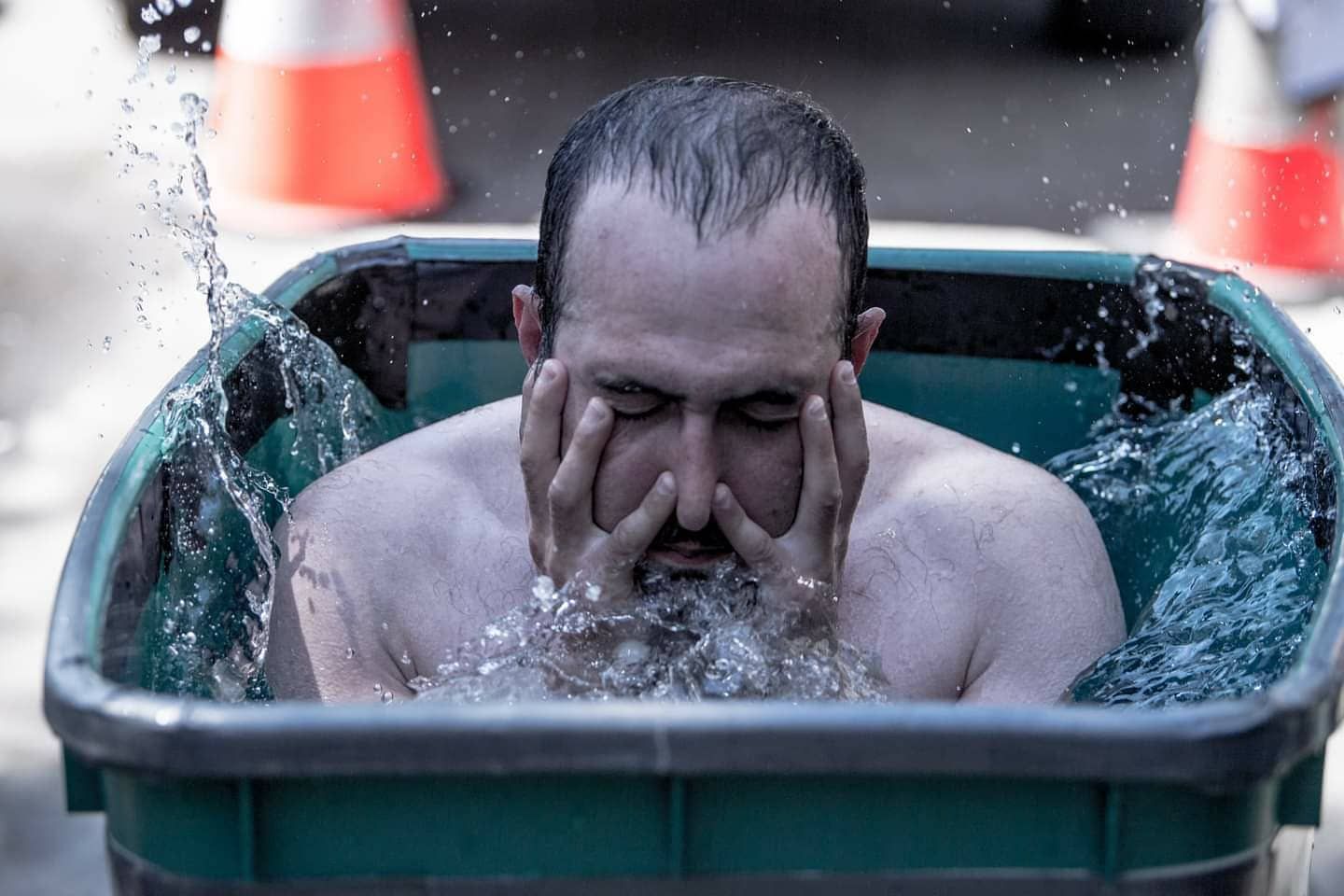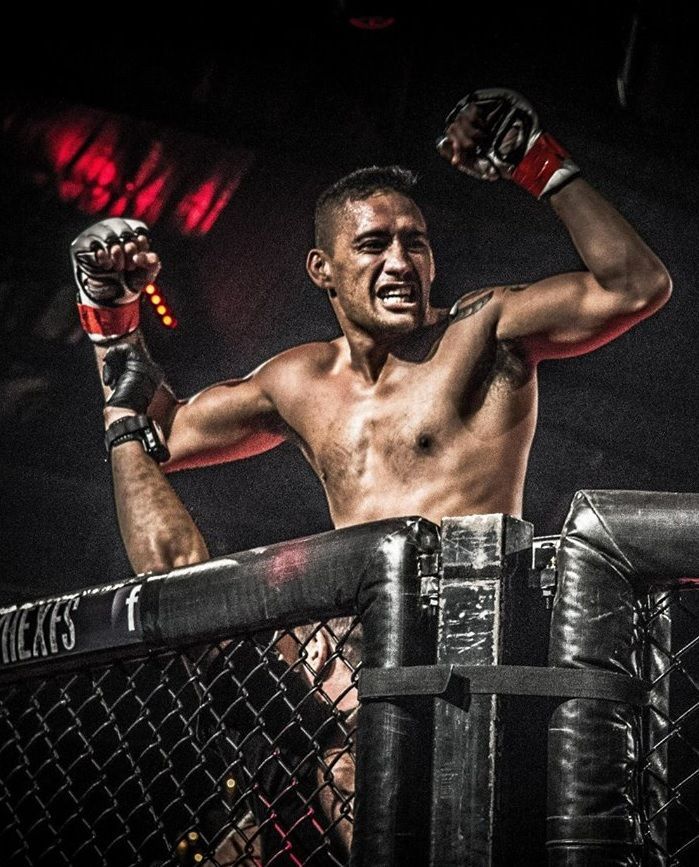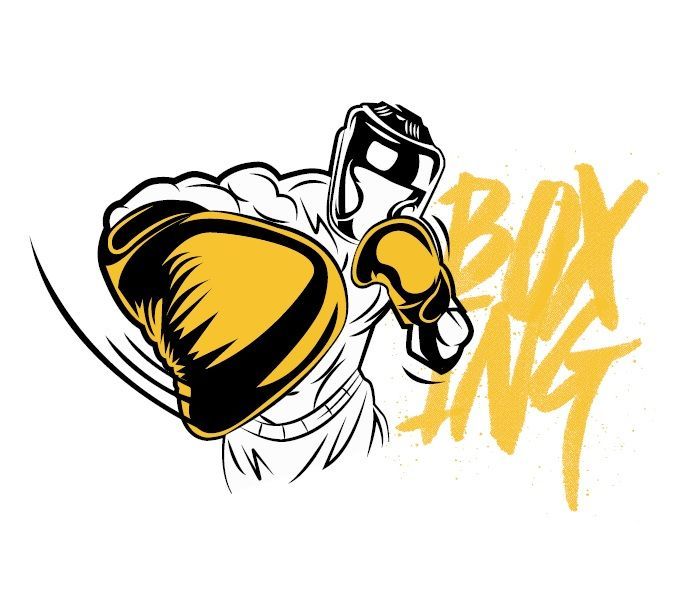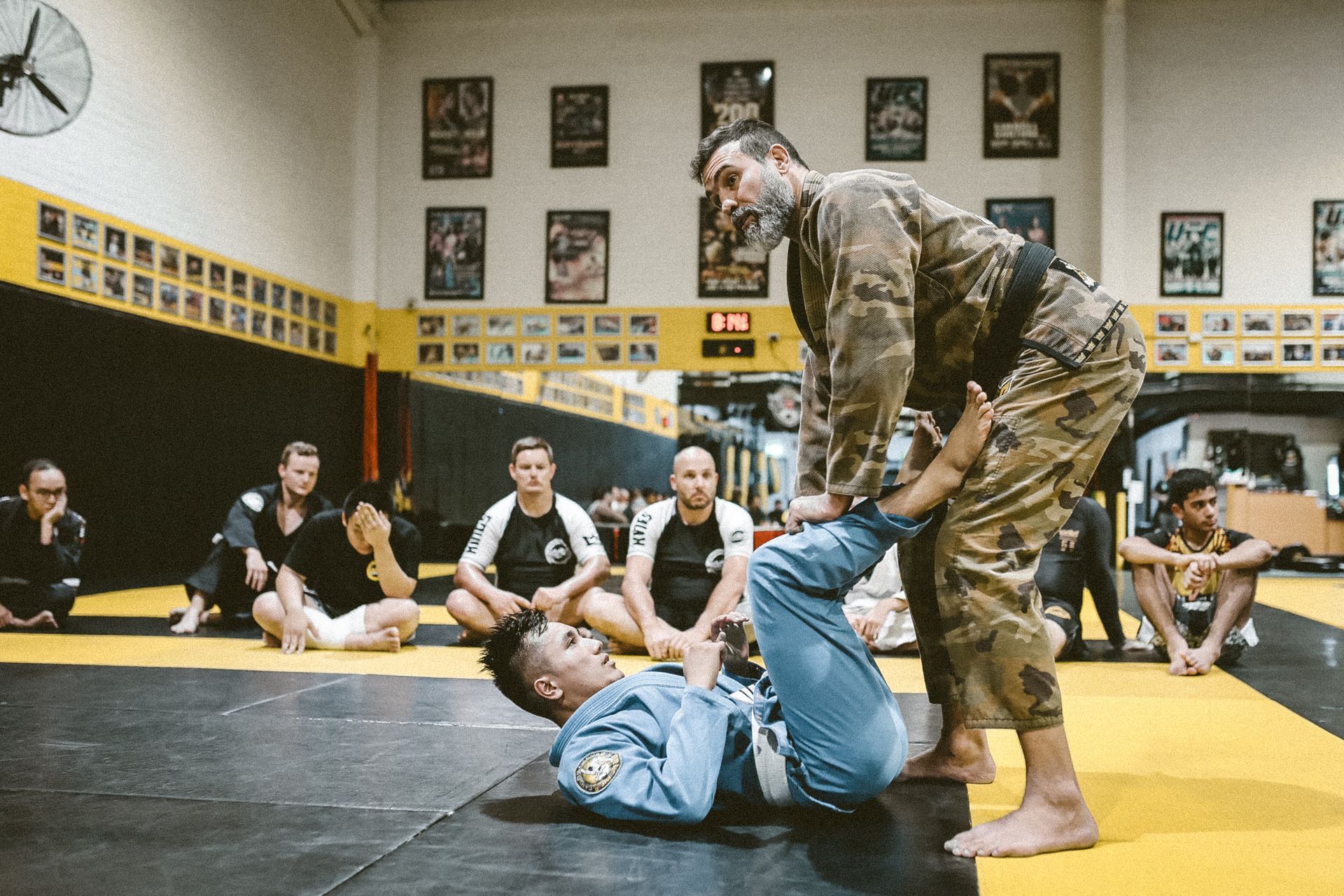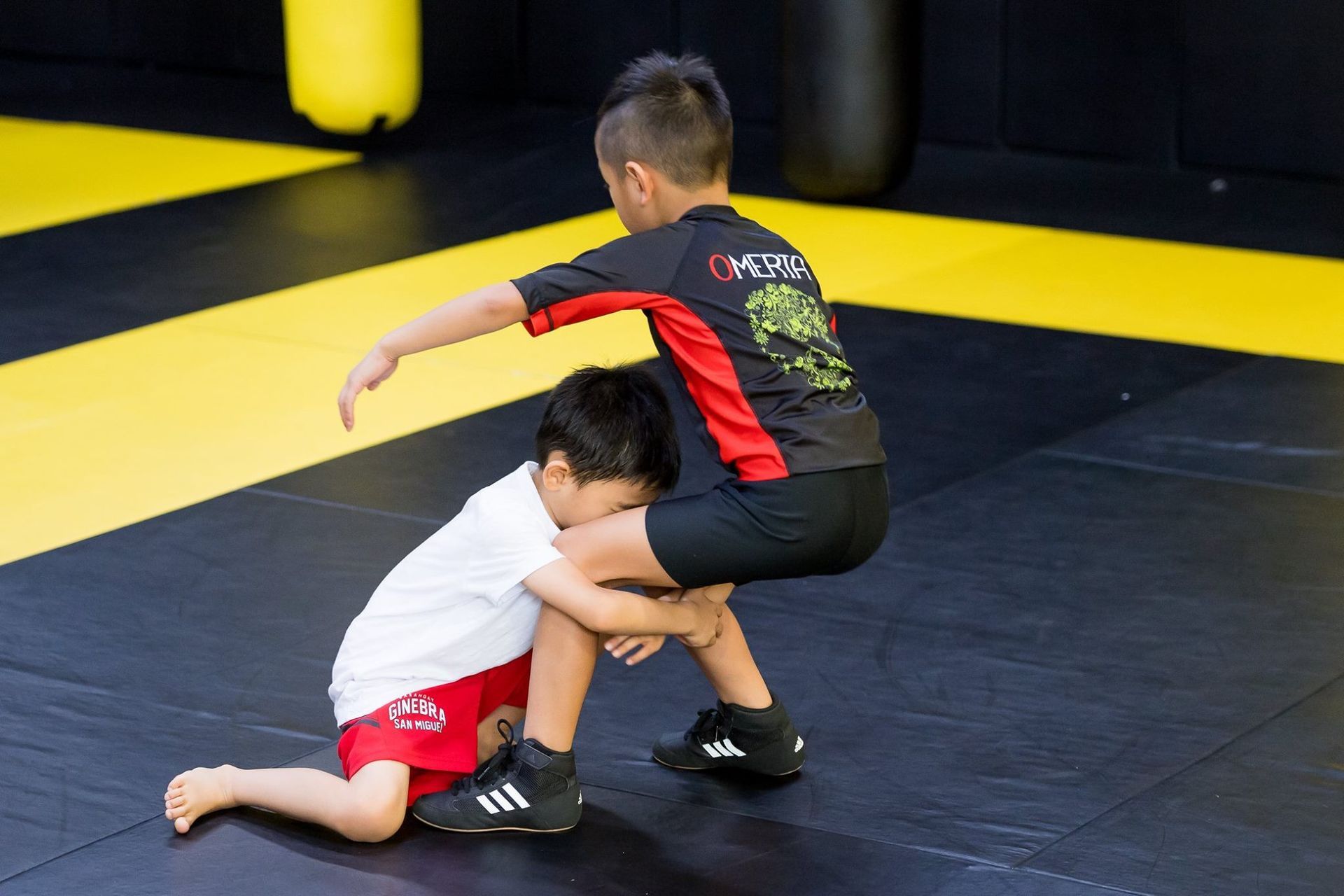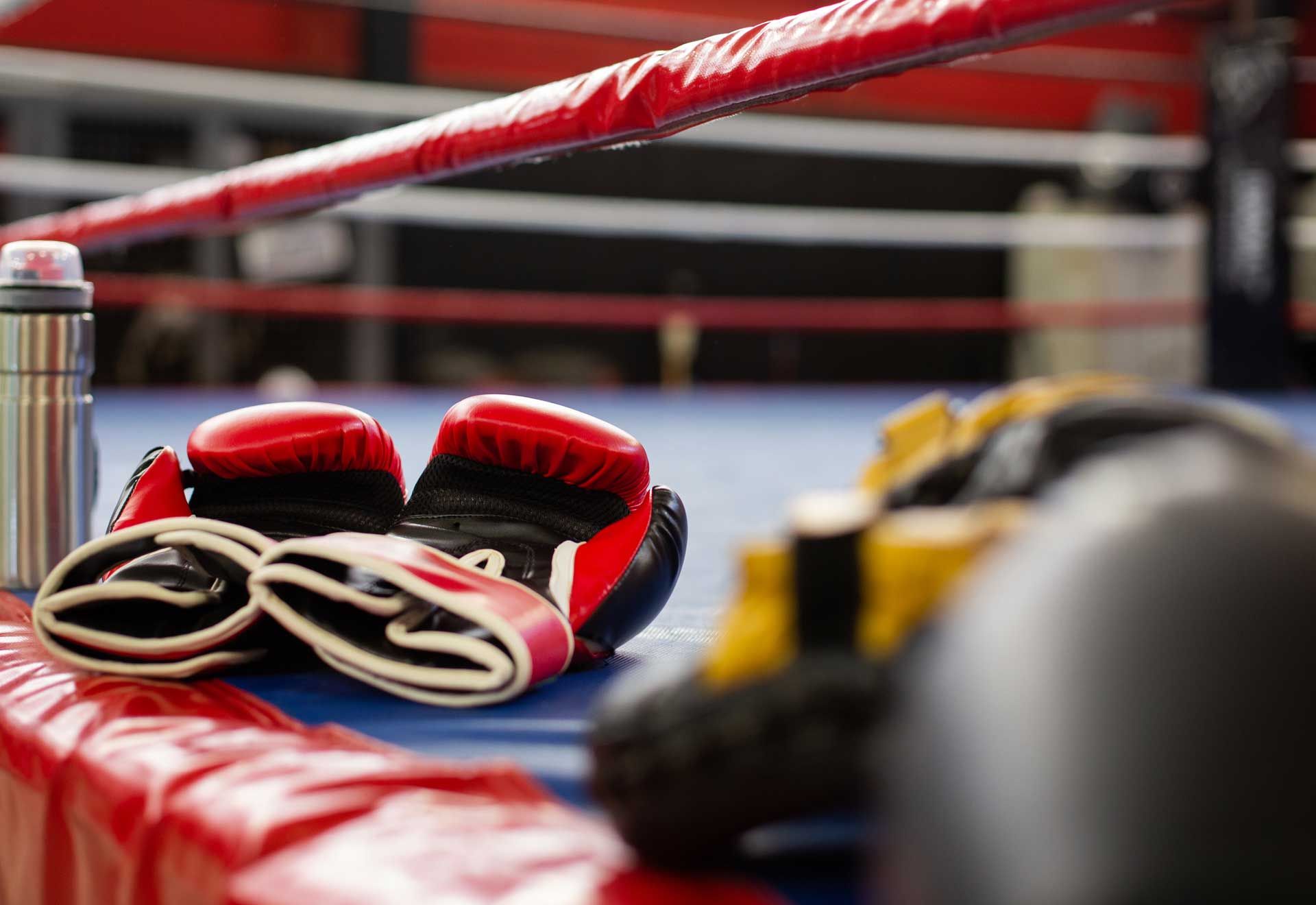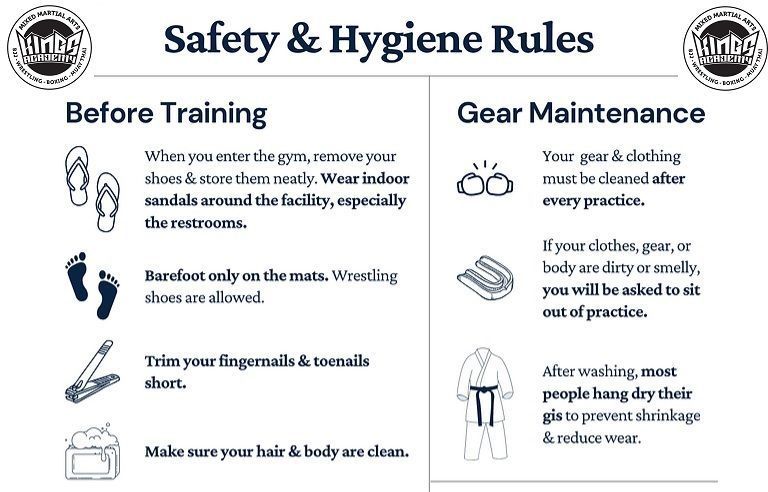Learn about Wrestling
Wrestling is a combat sport involving grappling-type techniques such as clinch fighting, throws and takedowns, joint locks, pins, and other grappling holds.
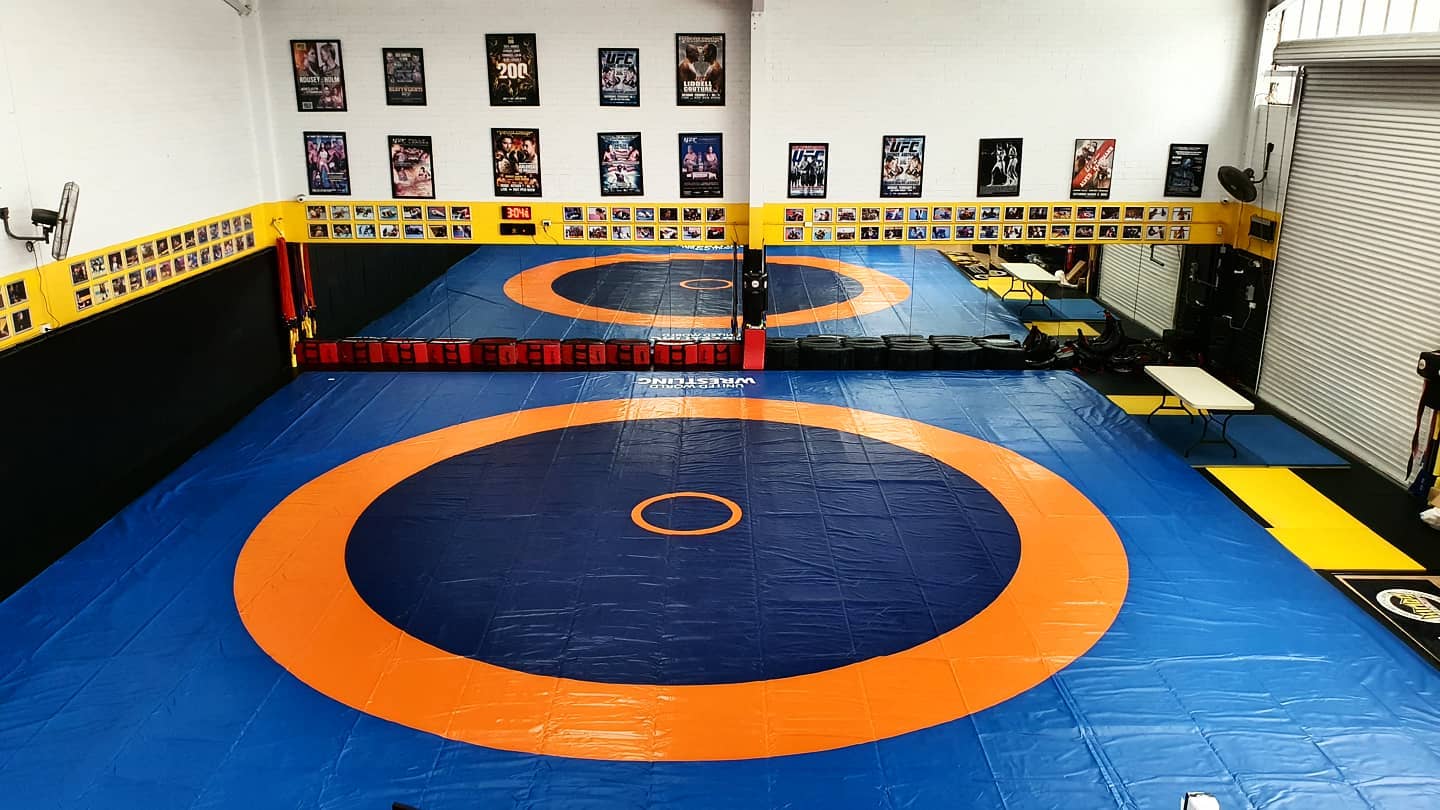
Learn About Wrestling
Everything you needed to know about Wrestling
If you're interested in checking out Wrestling at Kings please check out our Wrestling Page.
What is Wrestling?
Wrestling is a combat sport involving grappling-type techniques such as clinch fighting, throws and takedowns, joint locks, pins, and other grappling holds. The sport can either be genuinely competitive or sportive entertainment (see professional wrestling). Wrestling comes in different types such as Folkstyle, Freestyle, Greco-Roman, Catch, Submission, Judo, Sambo and others. A wrestling bout is a physical competition, between two (occasionally more) competitors or sparring partners, who attempt to gain and maintain a superior position. There are a wide range of styles with varying rules with both traditional historic and modern styles. Wrestling techniques have been incorporated into other martial arts as well as military hand-to-hand combat systems. Wrestling represents one of the oldest forms of combat that is practiced around the World.
What is Wrestling?
Wrestling, sport practiced in various styles by two competitors, involving forcing an opponent to touch the ground with some part of the body other than his feet; forcing him into a certain position, usually supine (on his back); or holding him in that position for a minimum length of time. Wrestling is conducted in various styles with contestants upright or on the ground (or mat).
Wrestling can also be classified in terms of what is required to win. These categories can be graded on an ascending scale of violence as follows: break-stance sports are those that require forcing the opponent to relinquish a certain posture or position; toppling requires that the standing opponent be forced to touch the ground with some part of his body other than his feet; touch-fall wrestling requires that the opponent be forced into a certain position, usually supine, for a brief instant; pin-fall wrestling requires that the opponent be held in such a position for a measurable length of time; and submission wrestling requires the opponent to vocally or visually signal defeat by his own choice.
No sport is older or more widely distributed than wrestling, often in highly local styles that have persisted to the present day.
History of Wrestling
Wrestling probably originated in hand-to-hand combat, and as a sportive form of combat substituting the submission of a contestant for his death. Works of art from 3000 bc depict belt wrestling in Babylonia and Egypt, and the Sumerian Gilgamesh epic has a description of such wrestling. Loose wrestling in India dates to before 1500 bc. Chinese documents from 700 bc describe loose wrestling, as do Japanese records from the 1st century bc. The belt wrestling practiced locally in the 20th century by the Swiss, Icelanders, Japanese, and Cossacks differed little from that of the Egyptians in 2500 bc.
Wrestling was probably the most popular sport of the ancient Greeks. Young men belonged to palaestras, or wrestling schools, as the focal point of their social life. Illustrations of wrestling on Greek vases and coins are common throughout all periods of ancient Greece, but all that can be told from it is that the style was loose wrestling and that wrestlers, as did all Greek athletes, competed naked. Wrestling was part of the Olympic Games from 776 bc. There were two wrestling championships in these games: a toppling event for the best two of three falls; and the pankration (Latin: pancratium), which combined wrestling and boxing and ended in the submission of one contestant. Upright wrestling was also a part of the pentathlon event in the Olympic Games, with a bout being fought to a clear-cut fall of one of the wrestlers. The most famous ancient Greek wrestler was Milon of Croton, who won the wrestling championship of the Olympic Games six times. Wrestling was less popular among the Romans than it had been with the Greeks, and, with the fall of the Roman Empire, references to wrestling disappeared in Europe until about 800ad.
Middle Ages
When the Islamic rulers of Persia began hiring Turkic mercenaries about 800ad, the soldiers brought with them a style of loose wrestling called Koresh, in which grips may be taken on the long, tight leather pants worn by the wrestlers and the bout ends with a touch fall of the loser briefly on his back. Gradually the Turks took over the entire Muslim dominion, and their wrestling style spread. Later Mongolian invasions in the 13th century introduced Mongolian wrestling, which received royal patronage, and wrestling became the national sport of modern Iran.
Sumo, a Japanese belt-wrestling style, was a popular spectator sport under imperial patronage (710–1185). Originally a submission spectacle, sumo became highly ritualized as a toppling match with victory coming also from the forcing of an opponent out of a 12-foot (4-metre) circle. By the 17th century sumo wrestling had become a professional sport in Japan. From the samurai martial art jujitsu, judo, the other prominent Japanese wrestling style, was derived in the 19th century and became an international sport in the second half of the 20th century.
Wrestling occurred in several styles throughout Europe in the Middle Ages. The first recorded English match was held in London early in the 13th century. In England and Brittany, a form of jacket wrestling commonly called Cornwall and Devon (see Cornish wrestling) survives from at least the 4th or 5th century. Wrestling as a martial skill was taught to the knights of the Holy Roman Empire, and wrestling instruction books appeared in manuscript before the introduction of printing and thereafter in print. Mongolian loose wrestling, introduced to India after the Mughal conquest of 1526, has survived in both India and Pakistan. As the modern era began, the English kings Henry VIII and Charles II and the French king Francis I were notable patrons of wrestling.
Modern wrestling
From the 18th century on, a procession of wrestlers or strongmen appeared at fairs, in theatres, and in circuses, challenging all comers, beginning with the Englishman Thomas Topham of London in the 18th century and culminating with Eugene Sandow, the German-born international figure, who continued into the 20th century. Early in the 1800s wrestling became a part of the training regimen of the German turnverein gymnastic movement. In the United States, wrestling was popular as a frontier sport (Abraham Lincoln was a noted local wrestler), bouts usually going until one contestant submitted and with few holds barred.
In the second half of the 19th century, two wrestling styles developed that ultimately dominated international wrestling: Greco-Roman wrestling and catch-as-catch-can, or freestyle wrestling. Greco-Roman wrestling, popularized first in France, was so called because it was thought to be the kind of wrestling done by the ancients. Greco-Roman wrestling involves holds made only above the waist and forbids wrapping the legs about an opponent when the wrestlers go down. Originally it was professional and popularized at international expositions held at Paris, but after its inclusion in the revived Olympic Games in 1896, Greco-Roman wrestling events were held at subsequent Olympic Games except in 1900 and 1904.
The second style, catch-as-catch-can, was popularized mainly in Great Britain and the United States, first as a professional sport and after 1888, when it was recognized by the Amateur Athletic Association, as an amateur sport. It was introduced into the Olympic Games of 1904 and contested thereafter except in 1912. Catch-as-catch-can permits holds above the waist and leg grips and is won by a pin-fall.
Freestyle, or international freestyle, wrestling is a synthetic form of catch-as-catch-can that came to be used in the Olympic Games after it first appeared in Antwerp about 1920. International freestyle is loose wrestling that uses the Greco-Roman touch-fall instead of the pin-fall common to Anglo-American wrestling practice.
Notable professional wrestlers in the late 19th and early 20th centuries included the Russian George Hackenschmidt, originally an amateur Greco-Roman wrestler who turned professional and wrestled catch-as-catch-can from 1900. He was world champion until 1908. The American wrestler Frank Gotch defeated Hackenschmidt in 1908 and again in 1911.
After Gotch’s retirement in 1913, professional wrestling, which was already fighting a losing battle in popularity with boxing, came to an end as a serious professional sport. Thereafter, though its audience grew, especially in the United States, through radio broadcasts and later even more so through telecasts, it became pure spectacle. The winners, divided deliberately into “heroes” and “villains,” were determined by promoters’ financial requirements, not skill. Wrestling manoeuvres became increasingly extravagant and artificial and lost most of their authenticity. Perhaps most theatrical of all is the style of professional wrestling known as lucha libre, a form that is commonly associated with Mexico and is known for its colourfully masked performers and aerial moves.
Though professional wrestling steadily declined in seriousness in the 20th century, significant improvements occurred in amateur wrestling during the same period. Originally there were no weight divisions in wrestling (the only weight in the first Olympic Games was heavyweight), but weight divisions developed in amateur wrestling. Earlier wrestling had been continuous and contested to one or two of three falls, sometimes with a time limit, sometimes without. Amateur wrestling came to be limited to three three-minute rounds effective in all international competition from 1967.
Perhaps most importantly, a system was devised in amateur wrestling to award points, short of a fall, based on one wrestler’s being in control of another, so that draw matches were made virtually impossible. This system arose because Greco-Roman wrestling, with its restriction to holds only above the waist and the forbidden use of legs for holds, tended to be dull once the wrestlers were on the mat. In the 1912 Olympic Games two Finnish Greco-Roman wrestlers had a six-hour bout to no decision. In response to this problem, several American colleges introduced the idea of recording the length of time each wrestler was in control of the contest during the course of a bout. (A wrestler is in control when he is applying manoeuvres that will eventuate in a pin-fall if his opponent is unable to escape.) In 1928 the National Collegiate Athletic Association adopted the collegiate style of wrestling as a national sport, and this resulted in the formulation of a set of point awards to keep a running score during a bout. The rules and judging are similar to those used in international freestyle and Greco-Roman bouts and include awarding points based on reversing control, applying a pinning hold, and placing an opponent in danger of pinning. The running point score and the difference in control time are used to decide a victor in no-fall bouts. The collegiate style of wrestling became increasingly popular in the high schools and colleges of the United States after World War II.
In the 20th century a third international style of wrestling, sambo, a kind of jacket wrestling, was created by Anatoly Kharlampiev of the Soviet Union and others after a study of various traditional wrestling styles. Sambo became popular in the Soviet Union, Bulgaria, and Japan and in 1964 was internationally recognized. In sambo a wrestler wins by throwing another cleanly on his back, or if the wrestlers go to the mat, the bout ends with the submission of one opponent. Sambo is much like judo and Mongolian wrestling, and bouts are of three three-minute rounds.
There was never any attempt to organize professional wrestling in the Western world. Amateur organization was local and national from the early 19th century on, regional competition began late in the 19th century, and in 1911 the Fédération Internationale de Lutte Amateur (FILA; International Amateur Wrestling Federation) was formed (reconstituted in 1920). The FILA regulates international competition, including the Olympic Games, and has held world championships in Greco-Roman wrestling from 1950 and in freestyle from 1951. World championships and Olympic championships in judo, sponsored by the International Judo Federation (formed in 1951), have been held from 1956 and 1964, respectively.
Principles and practice
Under FILA rules, contests of both international freestyle and Greco-Roman styles of touch-fall wrestling are similar, the object being in each case to throw or press the opponent on his back so that his shoulder blades touch the ground simultaneously. This need occur only for an instant, but a continuous roll across the shoulders is not considered a fall.
The competitors meet on a large padded mat and commence by taking holds from a standing position. Their struggle is observed and controlled by officials, one of whom, the referee, stands on the mat with the wrestlers and signals the award of points for manoeuvres leading toward a touch-fall. If no fall occurs before the expiration of the match, these points are used to determine a winner. The actual match is continuous except that it is divided into three periods with a brief rest in between. Ties or draws are common in wrestling.
The competitors make use of techniques that are best learned by practice. While standing, they strive to bring each other to the mat with a series of manoeuvres known as takedowns, involving lifting, throwing, twisting, tackling, and tripping. When attacked, a wrestler applies counterattacks to convert the situation to his own advantage. If the wrestlers go down on the mat without a touch-fall, they proceed to grapple, seizing each other with various grips and counter grips to work toward a fall. Great strength, though an asset, is not a prerequisite, since most of the manoeuvres employ the principle of leverage; quickness and good physical condition are far more essential. The action in wrestling proceeds at a furious pace and involves all muscles of the body. The use of weight classes prevents the pairing of any two men with more than a few pounds difference between them.
Although the Spartans trained young girls as wrestlers in ancient Greece and an occasional female wrestler, if only legendary, such as Zenobia, has appeared, wrestling by women occurred in the 20th century only as a novelty spectacle.
The Sport of Wrestling
The objective of each wrestler is to pin the opponent and establish own superiority without violence. While doing so, the wrestlers perform various techniques such as taking down, joint locks, pins, and grappling holds.
The judges award points for each successful move to pin down your opponent. The team having maximum points at the end of the match is declared as winner.
Wrestling – Regulating Bodies
An international governing body named United World Wrestling (UWW) is for the sport of wrestling. It was formerly known as International Federation of Associated Wrestling Styles or in French, Fédération Internationale des Luttes Associées (FILA).
It oversees wrestling at the Olympics. It presides over international competitions for various forms of wrestling, including Greco-Roman wrestling and freestyle wrestling for men and women. UWW sets rules and regulations and holds international competitions in the following wrestling styles −
Greco-Roman Wrestling
Freestyle Wrestling (Men’s and Women's)
Grappling
Beach Wrestling
Amateur Wrestling
Weight Throwing
UWW conducts a flagship event named Wrestling World Championships.
Wrestling – Participating Countries
Wrestling is present in the Olympic Games since its inception. Since its introduction to Olympiad Games, the popularity and demand of this game by different nations grew exponentially. Many Asian and non-Asian countries have their active participation in this category of game.
Some of the dominating Asian countries participating in Wrestling are Japan, Iran, India, Uzbekistan, and South Korea. In 2014 Asian games, Yogeshwar Dutt of India bagged the gold medal in men’s 65 Kg freestyle category and Rio Watari of Japan bagged gold medals in women’s 63 Kg freestyle category respectively.
Similarly many non-Asian countries have shown their talents in events like summer Olympics. Countries such as Russia, USA, and Azerbaijan are dominating in the competitions. In 2012 Summer Olympics, Jordan Burroughs of USA bagged the gold medal in men’s 74 KG freestyle category while Natalia Vorobieva of Russia bagged gold in women’s 72 Kg freestyle category respectively.
Wrestling - Equipment
Wrestling is the low key game as far as the number of special equipment are concerned. The wrestlers compete in the area which can take the shocks of their actions. The wrestlers enter the game area hands-free.
Wrestling Mat
Wrestling mat is the primary equipment required in the game. The mat is designed such that it protects the wrestlers and enforces the rules for each style. The wrestling mats come in various versions such as High-school mats, Practice mats, and International Mats.
International Regulation Wrestling Mats
The dimensions of mats must be uniformed and adhere to the International Federation of Associated Wrestling Styles (FILA) guidelines.
Mats may not be used for more than one year
An official must approve every mat before a competition.
The thickness of mats must be between 5 and 7 centimeters with a core made of high-density, shock-absorbing foam.
The surface of the mat must be of a non-abrasive vinyl material that can easily be cleaned and prevents slipping.
Square-shaped mats must be 12 meters X 12 meters.
Octagonal-shaped mats should have a diameter of 15 meters.
Wrestling Singlet
Wrestling singlet is a garment of one piece that covers the torso of the wrestler. For protection of the shoulders, straps are provided over it.
Singlet is made of Lycra or Nylon. It is mandatory to wear if the wrestler is participating in tournaments. A particular team wears singlet of a single color.
Wrestling headgear is not an essential item, but it is necessary enough to wear a headgear if you are playing in a higher level match where it can get more physical. There is a single size head gear available that can fit all with adjusting straps.
Headgears are designed to protect the wrestler's ears. Without headgears, a wrestler may suffer from "cauliflower ear" which occurs after someone gets repeated hits to the ear. Wrestlers are likely to have cauliflower ear because their ears may be hit while they're in a match. These blows can damage the shape and structure of the outside of the ear.
Wrestling Shoes
The shoes need to be very soft and lightweight. This is because the wrestler needs to be feel light during the match. Unless you are playing for very long hours, this is also not a mandatory item to invest in.
Wrestling Kneepads and Mouth Guards
Kneepads are used for the protection of knees. During the shooting process most of the wrestlers get hurt on their knees, so this is an essential item.
On the other hand, mouth guards are used to protect the teeth of the wrestler during the match. These are like braces that the wrestler wears inside of his mouth.
Wrestling Bands
Generally, two types of bands are used in a match: red and green. One wrestler is given red band and other is given a green one. These are needed to be placed on the ankle of the wrestler.
Bands make the identification and scoring of the wrestler easier for the referee. The referee has these two types of bands with him wrapped on his wrists.
Wrestling - Playing Environment
Wrestling is an indoor sport. Apart from the area allocated for wrestling match and viewers, the playing environment involves a jury of three officials −
Referee − The referee controls the action in the centre and blows the whistle to start and stop the action.
Judge − He sits beside the mat to keep score and give occasional approval when required by the referee on various decisions.
Mat chairman − The mat chairman sits at the scoring table and keeps time. He is responsible to declare technical superiority and supervise the work of the referee and the judge. To call a fall, any two of the three officials must agree.
Wrestling - The Rules
In wrestling, a pin (or a fall) is when you bring down your opponent on his/her back with any part of both shoulders or both shoulder blades. Your opponent’s back or any body part said above should stay in contact with the mat for at least two seconds.
If nobody gets pinned, the wrestler who scored the most points during the match is declared as a winner. Let us see the rules regarding points and illegal actions on the mat −
Wrestling – Weightage of Points
There are multiple ways you can score points of the following weightage in a wrestling match legally −
Takedown (2 points)
Escape (1 point)
Reversal (2 points)
Near Fall (2 pints if lasts for 2 seconds or 3 points if lasts for 5 seconds)
Penalty Points (1 or 2 points)
Wrestling Rules Regarding Illegal Holds
The referee can penalize you for −
Grabbing the singlet, the mat, or the headgear.
Locked or overlapped hands: If you are down on the mat in control of your opponent, you cannot lock or overlap your hands, fingers or arms around your opponent's body or both legs unless −
You have fulfilled the criteria for a near pin of your opponent.
Your opponent stands up and has all his/her weight on two feet.
You have lifted the opponent off the mat.
Wrestling Rules Regarding Technical Violations
The referee can penalize on the violation of the following rules −
Going off the mat or forcing your opponent off the mat to avoid wrestling.
Leaving the mat during the match without the referee's permission.
Reporting to the mat not properly equipped or not ready to wrestle, or with the illegal equipment at the time of starting the match.
Bringing roughness in the game unnecessarily.
Conducting oneself indecently or unsportsmanlike.
Incorrect starting position or false start
The first and second time you are penalized, your opponent is awarded one point. The third time you are penalized, your opponent is awarded two points. The fourth time you are penalized, you are disqualified.
The rules for various wrestling styles in the Olympics and international championships are different.
Wrestling - Scoring
While you start practicing this combat sport, you must become aware of various techniques of scoring and signalling used by referees. You also must know the categories of Wrestling Championships.
The following table lists the points that are assigned for different cases in a match −
Cases Points
Escape 1 point
Stalling 1 point (after 1 warning)
Technical Violation 1 point
Takedown 2 point
Reversal 2 point
Near fall(Injury) 4 point
Near fall (2 sec) 2 points
Near fall (5 sec) 3 points
The following table lists the different cases of scoring points for the team −
Cases Points
Fall (Pin) 6 points
Tech Fall (margin 15+ points) 5 points
Major decision (margin 8-14 point match) 4 points
Decision (Major 1-7 match point) 3 points
Major Decision (margin 8-14 points) 4 points
Learn Wrestling Fundamentals
How to Stand
Two basic stances are used in wrestling — the square and staggered stance. In the square stance, your feet are parallel with each other and your weight is evenly distributed on both feet. In the staggered stance one foot is ahead of the other and more weight is on the front foot. With both stances your feet are slightly wider than shoulder-width apart, your knees and hips are bent, and you lower your body to lower your centre of gravity. Lean forward with your chest over your knees and jut your butt backward. Bend your elbows, keep them close to your torso and hold your hands in front of your body. Keep your back slightly rounded, head up and eyes focused on your opponent.
Breathing properly
Before engaging in any attack or defence techniques on the mat, you must know how to breathe properly. Each movement should be accompanied by the right breathing technique so you won’t get tired or lose too much oxygen at once. For instance, slow movements require slow breathing techniques by inhaling and exhaling through the nose. On the other hand, explosive breathing boosts your body, preparing it for explosive or “quick attack” moves on your opponent. The trick is to breathe slowly and exhale as quickly as you can.
Penetrating Shot
A must-know move is how to penetrate through your opponent’s defences, namely their hands and arms. To do this, start in a staggered stance, lower your body toward the mat, shift your weight onto your back foot and take a step forward between your opponent’s legs with your lead foot. Roll forward over the toes of your lead foot and land on your lead knee. Bring you back foot up and plant it firmly on the mat as your reach forward to grab one or both legs of your opponent.
Lift Your Opponent
Lifting is a basic move typically used in an attempted takedown. Start by standing to the side or behind your opponent with your hips squarely beneath your shoulders. Wrap your arms around his waist and lock your hands. Pull your opponent into your body and lower your hips lower than his. While keeping your opponent tight against your body, push through your legs, drive your hips forward into your opponent and straighten your legs to lift him off the mat. Maintain control and safely lower him to the mat for the takedown. Avoid throwing or slamming your opponent to the mat because this is illegal.
Learn to Escape
The escape is an essential move to take you from the bottom starting position, on your hands and knees with your opponent on top, to a standing position. Begin by moving your foot to the side, away from your opponent. For example, if your opponent is on your left holding you, move your right foot to the right. Simultaneously lift your right knee, plant your right foot on the mat, lean back into your opponent and push through your right foot to get up from the mat. Grab and pull on the wrist that’s around your waist as you quickly pivot and turn to escape his hold.
Know How to Pin
The half nelson is one of the most common pinning moves. When your opponent is face down on the mat, slide either your right arm under his right armpit or your left arm under his left armpit. Put the palm of your hand on the back of his head, not his neck. While pushing on the back of his head, lift his arm up with your arm and move your body to the side of his body. For example, if you put your right arm under his arm and your right hand on his head, move to your right as you lift his arm. Slowly walk your feet forward and push into him with your upper body to roll him over for the pin.
Leg trip
The leg trip is a technique in which the combatant uses his or her own leg(s) to off-balance an opponent, hence causing the opponent to fall to the ground. Leg trips are often integrated into more complex takedown techniques and are also important in many throws. Takedown techniques that are pure leg trips usually involve controlling the body of the opponent and impeding or destabilising one or both of the opponent’s legs.
Single leg takedown
The single leg takedown (often shortened to single leg or single or single leg shot) involves grabbing one of the legs of the opponent, usually with both hands, and using the position to force the opponent to the ground. Typically, the lower part of the leg is pulled in one direction, while the torso or shoulder is used to press the body or upper part of the leg of the opponent in the other direction.
There are several varieties of single leg takedowns. Some involve picking up and holding the leg by the ankle and are often known as ankle picks, while other varieties include the high crotch, in which the leg is held high up in the opponent's crotch area. The leg can be attacked either across the body ("inside") or from away from the body ("outside"). Single leg takedowns can also be executed in combination with a leg trip to the other leg, which additionally destabilizes the opponent.
Double leg takedown
The double leg takedown (simply known as a double leg or even double) involves grabbing the opponent with both arms around the opponent's legs while keeping the chest close to the opponent and using this position to force the opponent to the ground. There are several varieties of forcing the opponent to the ground, such as lifting and slamming, or pushing forward with the shoulder while pulling the opponent's legs. Another form of a double leg takedown is the double leg and trip, in which the person shoots in and while holding both legs swing one of his legs around and pushes forward on the opponent while tripping the opponent's leg out from under him.
Duck Under
In a duck under, the wrestler pulls the opponent's elbow forward and away from the body, lowers his own head, and ducks under the opponent's arm to get behind or at least beside the opponent; from this position the opponent can be taken down by lifting and throwing or by a leg trip.
Fireman's Carry
The fireman's carry is a takedown technique that resembles a common method of carrying an injured victim by firefighters. When implemented on the right side of the opponent's body, the attacker's left hand pulls the opponent's right elbow forward so the attacker's head goes under the opponent's right arm. At the same time, the attacker's right hand grabs the inside of the opponent's right thigh and lifts, while the attacker rises and drives to his left, bringing the opponent down to the ground on his right side.
Under Hook
A single under hook involves putting an arm under the opponent's arm and holding the back of the opponent's midsection or upper body, while a double under hook involves doing this with both arms. Either can be used as the basis for a takedown because under hooks offer the potential for control of the opponent's upper body.
Over Hook
A single over hook, or whizzer, involves putting an arm over the opponent's arm and encircling it. It can be used as a takedown manoeuvre by putting substantial weight on the targeted arm while pulling the opponent's other arm across his body, and eventually stepping over behind the opponent.
Bear Hug
In a bear hug, the arms are wrapped tightly around the opponent's midsection, sometimes with one or both opponent’s arms pinned to the opponent's body, so that the opponent's chest is held tightly to the attacker's chest. From this position the opponent can be taken down, sometimes by lifting and tilting and sometimes with the aid of a leg trip.
Spin-Around
The spin-around is often used as a counter to an opponent's attempt at a single, or double,leg takedown. When the opponent shoots for the legs, the targeted wrestler sprawls his legs part way back and then quickly moves around behind the opponent.
Snap Down & Spin-Around
In a snap down, both hands are placed on the back of the opponent's neck, and when the opponent's head is held low or is becoming lower both hands pull down sharply, propelling the opponent's head and therefore body toward the ground. Simultaneously the attacker steps around behind the opponent.
The Sprawl
If your opponent tries to attempt the single or the double-leg takedown on you, the best way to defend yourself is through a sprawling technique. The method should basically teach you to deny your opponents the necessary elements to finish their takedowns and put you on the mat. You should anticipate the move and drop your hips, shifting your legs in different directions, usually backwards and/or the side. Use your hands to push down on your opponent’s head and prevent him from completing the takedown. This will create enough confusion, determining your competitor to abandon his intentions.
Sit-out Escape
This is one of the simplest and most common escapes from referee's position. It begins by leaning backward into your opponent while thrusting both feet forward until you're in a sitting position. From there, you can leverage yourself to your feed for a stand-up or reach behind to capture a leg and use a turn-in reversal.
Granby Roll
One of the more dynamic moves in a wrestlers arsenal, this roll uses an opponent's weight against him. Used when you are on your hands and knees with your opponent on top of you, you perform it by capturing one of your opponent's arms, then doing a forward shoulder roll. If his weight is high enough, he'll roll with you and end up on his back with you lying on top of him.
Tight Waist
Also called a "deep waist," this move helps control an opponent from the "on top" position as he tries to escape. You simply wrap one arm around his stomach until you can grip his opposite ribs or armpit. This compresses his diaphragm while giving you a solid grip on his torso. Do not grab your opposite hand in a bear hug from this position - it's an illegal hold.
Leg Ride
A leg ride rarely pins an opponent but will reliably roll him over to score near fall points. Start a leg ride from behind your opponent by slipping one leg between the legs of your opponent, then wrapping it to trap one of his legs. Then grip his head or shoulder and arch your hips forward. This stretches and immobilizes your opponent. At that point, you can roll him over onto his back.
Wrestling - Champions
Every participating country has its own governing body to organize the game successfully throughout the calendar. Here is a list of some important tournaments in this category.
Asian Games
Olympic Games
World Championships
Commonwealth Games
Continental Championships
Mediterranean Championships
Based on the wrestler’s weight, the terms used are as follows −
Weight Term
115 pounds (52 kg) Flyweight
139 pounds (63 kg) Featherweight
150 pounds (68 kg) Lightweight
161 pounds (73 kg) Super Lightweight
170 pounds (77 kg) Welterweight
181 pounds (82 kg) Super Welterweight
192 pounds (87 kg) Middleweight
203 pounds (92 kg) Super Middleweight
214 pounds (97 kg) Light Heavyweight
231 pounds (105 kg) Junior Heavyweight/Cruiserweight
231 pounds (105 kg Minimum) Heavyweight
Wrestling – Hall of Fame
Many wrestlers have left and are still leaving their mark on various championships and international tournaments.
Aleksandr Karelin
Aleksandr Aleksandrovich Karelin (born 19 September 1967) is a retired Greco-Roman wrestler for the Soviet Union and Russia. Nicknamed the "Russian Bear", "Russian King Kong", "Alexander the Great" and "The Experiment", he is widely considered to be the greatest Greco-Roman wrestler of all time. Karelin won gold medals at the 1988, 1992 and 1996 Olympic Games under a different flag each time (Soviet Union, Unified Team and Russia respectively), and a silver medal at the 2000 Olympic Games. His wrestling record is 887 wins and two losses, both by a single point. Prior to his farewell match versus Rulon Gardner in September 2000, a point had not been scored on him within the previous six years. Karelin was the national flag bearer at three consecutive Olympics: in 1988 for the Soviet Union, in 1992 for the Unified Team, and in 1996 for Russia.
Dan Gable
Danny Mack Gable (born October 25, 1948) is an American former folkstyle and freestyle wrestler and coach. Considered to be one of the greatest wrestlers of all time, Gable is a two-time NCAA Division I national champion, a world gold medallist, and an Olympic gold medallist. Gable was only the third wrestler to have ever been inducted into the United World Wrestling's Hall of Fame in the Legend category. Gable’s accomplishments as a coach surpass his individual accomplishments. He started as a coaching assistant for the University of Iowa’s wrestling team and was promoted to head coach in 1972. Gable ended up being one of the most successful coaches in NCAA history, taking his team to 45 National Championships, creating 152 All-Americans, 106 Big Ten champions and 12 Olympic medallists as the U.S. Olympic team’s freestyle coach.
Cael Sanderson
Sanderson is easily the best American wrestler in recent history. His journey to greatness started in the NCAA where he went undefeated, compiling a 159-0 record. Sanderson also won four NCAA championships during his college days, four NCAA Outstanding Wrestler of the Year awards and four Big 12 titles. Afterward, Sanderson represented the U.S. in the 2004 Summer Olympic Games, winning the gold medal. He is now the head coach of the highly successful Penn State University wrestling program.
Artur Taymazov
Arthur is an Ossetian-Uzbek wrestler and Uzbekistan's most decorated Olympian. He is from Tashkent. He decided to wrestle at the age of 11 years, when a freestyle wrestling club was opened in his village. He participated in London Olympics 2012, Beijing Olympics in 2008, and Athens Olympics in 2004 in which he received gold medal in 120Kg freestyle wrestling. In the Asian Games conducted in years 2000, 2006, and 2010, Arthur received gold medals in 130 Kg freestyle wrestling.
Armen Nazaryan
Armen is an Armenian Greco-Roman wrestler who represented Bulgaria. He won the European Championship six times in 1994, 1995, 1998, 1999, 2002, and 2003. He won World Champion three times (in 2002, 2003, and 2005). Armen also has to his credit two Olympic titles. He was recognized by the FILA as the best fighter of the year in 1998 and 2003. He was awarded as coach of the year for all sports in Bulgaria in 2013.
Sushil Kumar
This World Championship gold medal winner hails from a Hindu Jaat family of Delhi, India. He started wrestling at the age of 14. He started taking lessons in freestyle wrestling at Chhatrassal Stadium Aakhada (Wrestling School). He won two gold medals in Commonwealth Games, once in 66Kg category at Delhi in year 2010 and another in 74Kg category at Glasgow in 2014. He also won a silver at the 2012 London Olympics and a bronze at the 2008 Beijing Olympics.
Hamid Sourian
Without a doubt, Sourian is one of the best Greco-Roman wrestlers on the planet. Born in 1985, the Iranian has already secured six world championships. He won the gold medal in the men’s 55 kg division at the 2012 Summer Olympics, becoming the first Iranian to accomplish that feat. Sourian also has two Asian Championships gold medals and two Wrestling World Cup gold medals. His unmatched accomplishments on the mat have earned him the nickname “Genius.” Given his age, it’s safe to say Hamid isn’t done dominating opponents on the mat.
John Smith
Born in 1965, John Smith is one of the most decorated American freestyle wrestlers. His journey began at during his time in college where he won two national championships. After his college days, Smith went on to win two Olympic gold medals, four World Championship gold medals, two Goodwill Games gold medals, and two Pan American Games gold medals. As of today, there is no American wrestler who has come anywhere close to achieving the things Smith has. Smith competed in the NCAAs under Oklahoma State University’s banner. He compiled a 154-7-2 record during his years there. After his decorated wrestling career, Smith became the head coach of OSU’s wrestling team. His record as a coach is 425-63-6 and his pupils have won a total of 32 individual national championships.
Jordan Burroughs
Burroughs is a young American wrestler whose name often pops up during discussions about who is the best wrestler ever. Born in 1988, Burroughs has already amassed an impressive NCAA record and two National Championships. He won a gold medal at the 2012 Olympics, four World Championship gold medals, two Pan American gold medals and two Pan American Championship gold medals. Burroughs finished his collegiate career with an overall record of 128-20. He is currently ranked second all-time in the U.S. in terms of his accolades as a wrestler.
Glossary of Wrestling Terms
-A-
Arm bar
A method of turning an opponent from stomach to back on the mat by wrapping an arm around the opponent's elbow and using the leverage of that hold to flip him over.
Arm throw
A move in which a wrestler throws the opponent over his shoulder by holding the opponent's arm.
-B-
Bottom position
The wrestler who is on hands and knees is in the bottom position.
Bout
A match between two wrestlers, which is made up of three periods of 1 minute to 1 1/2 minutes each. A bout ends before the regulation time in the event of a fall, a technical fall, an injury default, or a disqualification. If the bout is tied after time expires, there is an overtime period.
Breakdown
The act of getting an opponent to the mat on his stomach or side.
Bridge
An arched position adopted by a wrestler, with his back above the mat, usually to avoid being pinned but sometimes as an offensive move.
Bridge out
An escape move in which a wrestler rolls from a bridge onto the stomach.
-C-
Central circle
The inner circle, 1 meter in diameter, on the wrestling mat.
Central wrestling area
A circle, 8 meters in diameter, inside the passivity zone.
Control
A wrestler who has a dominant position that restricts the opponent's mobility is said to be in control.
Cradle
A hold in which one arm is around the neck of the opponent, the other around the neck, with the hands gripped tightly together.
Cross-face
A hold in which the wrestler's forearm is pressed across the opponent's face.
-D-
Default
A win declared because of the opponent's disqualification or injury.
Decision
A victory in which the winner leads the opponent by 1 to 11 points. Compare technical fall.
Disqualification
A wrestler may be disqualified for brutality or unsportsmanlike conduct.
Double-leg takedown
A move in which a wrestler takes the opponent down by grasping both of the opponent's legs and pulling them.
Duck-under
A takedown move in which the wrestler ducks under the opponent's arm to get behind him and then uses a lift, throw, or trip to take the opponent to the mat.
-E-
Escape
If an athlete gets out from being under control in the bottom position and gets to his feet, facing his rival, it is an escape, which scores one point.
Exposure
Turning an opponent's shoulders to the mat, thus exposing him to the possibility of a pin.
-F-
Fall
When both of the opponent's shoulders are in contact with the mat (a pin), a wrestler is awarded a fall, which wins the match.
Fireman’s carry
A takedown move in which the wrestler brings the opponent temporarily over his shoulders, then to the mat.
Folk style
A style of wrestling generally used in youth wresting, high schools and colleges, which is similar to freestyle wrestling but with more emphasis on control and safety.
Full nelson
A hold in which both of the wrestler's arms are passed under the opponent's armpits and both hands are on the back of the opponent's head; illegal in amateur wrestling. See also half nelson.
-G-
Grapevine
A hold in which a wrestler wraps a leg around one of the opponent's legs, often preparatory to a throw.
-H-
Half nelson
A hold in which the wrestler's arm is passed under the opponent's armpit and the hand is on the back of the opponent's head. See also full nelson.
Headlock
A hold in which an arm is around the opponent's neck and the hands are locked together. The opponent's arm must be gathered into the hold to prevent accidental choking.
-I-
Injury default
A win rewarded to a wrestler when the opponent cannot continue to compete because of an injury.
Injury time
A period during which a match is halted because one of the wrestlers is injured or bleeding. If the wrestler cannot continue within two minutes, the match ends with an injury default.
-L-
Leg shot
A quick move, involving a level change, in which a wrestler thrusts toward the opponent's legs in an attempt to get a lock on one or both of them.
Level change
Bending at the knees to raise or lower the hips in order to get into a new position for a hold or takedown move.
-M-
Mat
The mat for international wrestling competition has a central wrestling area, 9 meters in diameter, with a center circle 1 meter in diameter. Inside the contest area is a red band, 1 meter wide, known as the passivity zone.
-N-
Near fall
If a wrestler exposes the opponent's shoulders four inches or less above the mat or has one of the opponent's shoulders on the mat and the other at an angle of less than 45 degrees to the mat, it is a near fall, worth two or three points depending on the amount of time.
Neutral position
The position wrestlers take at the beginning of a match, standing and facing each other, but not in contact. Also known as standing position.
-O-
Overtime period
If the score is tied when time runs out on a bout, a one minute overtime period begins immediately. The first wrestler to score a point wins.
-P-
Pin
Forcing both of the opponent's shoulders to the mat. The result is a fall, which wins the match.
-R-
Referee’s position
Where one wrestler is in the bottom position on knees and hands.
Reversal
If the wrestler in the bottom position completely reverses the situation and comes to the top position in control, it is a reversal, worth two points.
-S-
Single-leg takedown
A move in which a wrestler takes the opponent down by lifting one of the opponent's legs.
Singlet
The one-piece uniform worn by wrestlers.
Slam
To lifting the opponent from the mat and bring him back down with
unnecessary force; illegal in amateur wrestling.
Sprawl
A move used to counter a leg shot. The wrestler throws the legs back and
arches the hips into the opponent to break the hold.
-T-
Takedown
When a wrestler takes the opponent to the mat from the neutral position, it is a takedown, worth two points.
Technical fall
If a wrestler accumulates a lead of 12 points or more, it is called a technical fall and that wrestler wins the match. Also known as technical superiority.
Throw
Any move in which a wrestler lifts the opponent from the mat, then brings him back down.
Tie-up
Any move in which a wrestler grabs the opponent's upper body to gain control.
Tilt
To turn the opponent so that his back goes from an angle of 45 degrees or more to less than 45 degrees.
Top position
The wrestler who is on top of their opponent who is.
Tournament
A series of bouts to determine championships in various weight classes.
Although you may hear the same move be called a variety of terms. These
are just a sampling of the most common terms. There will be many more to
learn as the season progresses!
If you've been thinking about trying a Wrestling class read our Blog Ten Resaons Why You Should Wrestle
If you're interested in booking a free trial please follow this link Book Now!
If you enjoyed this article please check out our other related blogs:
If you're interested in checking out Wrestling at Kings please check out our Wrestling Page.
Regards,
Kings Academy
The No.1 place for Wrestling in Liverpool and South Western Sydney! Kings Academy is the Premier Martial Arts Academy servicing Greater Sydney with classes in BJJ (Brazilian Jiu Jitsu), Muay Thai, Boxing, Wrestling and MMA (Mixed Martial Arts)

